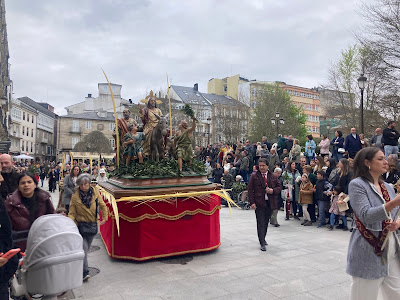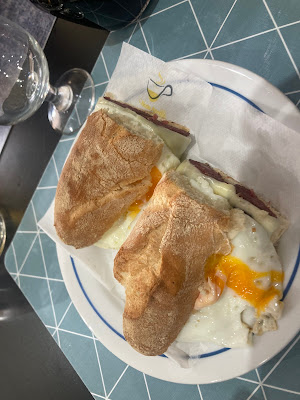The powers out in all of Spain and Portugal, plus some small areas of southern France. At least that’s what our B&B host tells us. It is suspected that It’s a cyber attack by Russia, but really at this point it’s anybody’s guess. We didn’t know it at the time, but I lost cell service and figured it was the E-Sim in my phone as it crashed once before. We went to a nearby restaurant for dinner and the lights were out in the dining room but it was unnoticeable due to many windows. After dinner we stopped at the gas station attached to the restaurant and was told, “no gas”. I then it dawned on us that the power was out.
We headed the short distance to our B&B and the gate was open confirming that there was no power at the B&B either. Ivan and Isabell were waiting for us at the front door with the news of the extent of the outage. Ivan still had cell service on his “company” phone so we had a conversation using Google Translate. No one knows when the power will come back on. I mentioned that I tried to get gas and Isabell told me they own the gas station. The gas station has a convenience store, so I suggested that we all go there and eat all the ice cream before it melted. Unfortunately that didn’t happen. So we wait to see what happens.
As of now we’re in limbo. With the inability to get gas we’ll have to cool our heals at our current B&B. We are in farm country near Lugo, a pleasant enough spot, but something gotta give at some point.
Update…..sometime around 6AM the power came back on. Some of the cities got power sooner than the rural areas, so the village where we are staying was at the back of the line. Everybody managed and by the time we got up everything was back to normal. Except for the ice cream, it all melted.
We had a little issue with the rental car, having suffered a flat tire. Of course there’s not spare and it’s the weekend. We were about 1/2 mile from our hotel, so we walked back and our host Alberto took over. Turns out Avis won’t send someone to fix the flat, but they will send a tow truck to tow it away. They also sent us a taxi to take us to Santiago, 1.5 hours away, to get a replacement car. Just as the taxi arrives, Alberto gets a phone call from Avis telling him that the Avis office at the Santiago Airport closes at 4 PM, 10 minutes from now being Saturday and all. So the taxi leaves to go back to Santiago without us and is rescheduled for the morning. Next morning at the appointed time the same taxi arrives and takes us to the Avis counter in Santiago. We pick up a brand new car for the last four days of this part of our Spain excursion.
Our next stop on our journey north was in the seaside resort of Sanxenxo where we rented an apartment for 3 nights. Situated right on the shoreline, it was one of the nicest places we have stayed. It had four bedrooms, a fully equipped kitchen, the all important washing machine plus a covered patio for watching the ocean. This city is known as a Spanish vacation destination for the rich and famous. Being off season, it was pretty much dead with many of the hotels and condos shuttered for the season. Still plenty on options for restaurants and uncrowded promenades for walking along the near empty beach. We had a relaxing 3 days.
The town we are in, is another fishing village, Camariñas. Actually more of the size of a small city, it had plenty of sea food restaurants to choose from. The town is on the Costa da Morte, or the Coast of death, because of the numerous shipwrecks along the rugged shoreline. We explored along a small gravel road for about 12 miles along the coast, taking in the sights and exploring a couple of beaches. This is also lighthouse country, mostly unmanned beacons warning ships of the dangers.
There have been over 600 recorded shipwrecks along this coast making it one of the most dangerous coastlines in Spain. Hidden rocks, powerful tides, and steep cliffs contribute to this high number. Some sources mention even higher figures, like 927 documented cases since the Middle Ages.
On the night of November 10th, 1890, amid terrible weather conditions, the English battleship Serpent ran aground at Boi’s Cape near Camariña. Locals quickly arrived only to find 3 survivors and 175 dead bodies that had washed ashore on the beach. There is a cemetery there where the bodies were buried.


















































